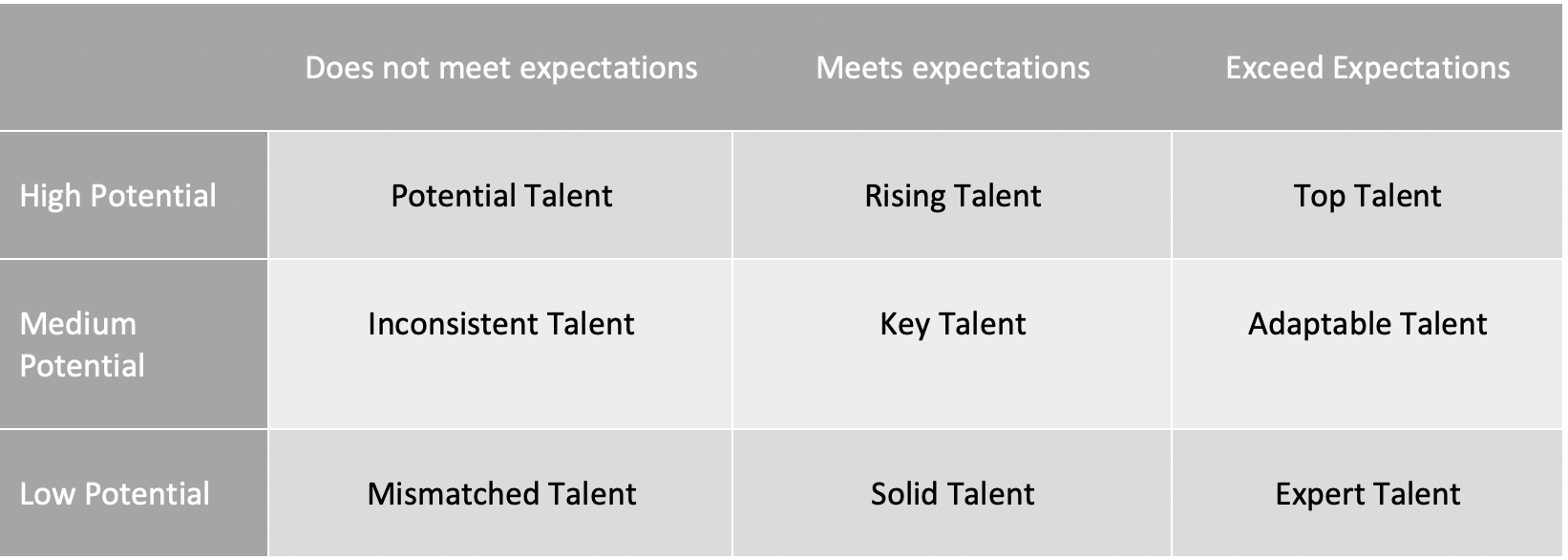Talent management: How to set the path for success for your company
Dieter Weisshaar • June 7, 2020
Photo by Guille Álvarez on Unsplash
How to discover and develop your talents
Today, it is harder to attract talented people and to convince them to join your team. There are a lot of opportunities out there. Hence, discovering and developing talents within your organization becomes even more important. But how can this be conducted?
Diversity is key for a great team
Diversity has many aspects. It starts with gender, culture and nationality, but experience, age, skills
and other aspects do matter as well.
First, it is important to understand if you have the right skills in your company
to run a well-oiled machine. That means you need excellence
in process, industry and people skills. If you miss one of those, you either need to hire or train your people. Hiring from outside the organization gives you fast access to excellent skills but it may be perceived as limiting career opportunities for the existing team. Still, compromising on people decisions should never be an option.
In the end, it is important to find a good mix
between your team being put on the right job, the excellence you may get from hiring and the talents you develop for a great future. This can lead to a good diversity in all aspects. Diversity will lead to better decisions and a great performance if you can form this team of excellence.
As a leader take your decision on the skills you need and understand the skills you have.
Discover your talents for your company’s future
If you join a management team which consists of white males in the 50ties
that have this close network which is hard to join, the young talents in your company may not receive a signal that there is a development opportunity.
Announce a talent program
and let the top talents of the company be nominated by all managers to a talent pool. Depending of the size of the company you may have various talent pools
by business unit and by talent level, such as leaders, managers or experts. The talent pool should be less than 10% of your employees.
Talent pools should be split by expert and leadership
path as the future development varies a lot. The experts should be able to follow on a non-management career path which equals at least the job level and payment of the first management position.
You will have two major learnings of this nomination process. The old saying will turn true: A-Player hires A-Player and B-Player hires C-Player. That means you will see nomination from managers which will not reflect your expectation of a top talent. B-Players play save that the nomination will not cause an issue for their own position but limit the ability to spot your talents. You can judge on your team of leaders
or managers as well by the nominations given.
Second, there will be jealousy. Some employees will not be happy and may oppose. A good, honest and transparent communication around the program is mandatory and it should focus on the advantages for the organization, the individuals and the investment.
Get the process structured.
First of all, communicate purpose and meaning
– this will attract especially young talents.
Discover the best talents in your organization by structuring the process to get optimal results.
1. Support the nomination by a set of criteria: team management-, social-, communication-skills, performance, engagement, positive attitude etc.. Let everybody rank the capabilities from 10 to 1 to get a comparable picture.
2. Establish a talent review board
with your direct reports where all nominated potential talents will be discussed and reevaluated. That means that your team needs to agree on the talent pool.
3. Rank the talents in two dimensions: Performance
and Potential.
Both dimensions have three levels: poor, average, high. That leads to nine clusters from no talent to top talent. You get your talent grid.
Picture: talent grid
As soon as you have your first talent pool, you need to make an evaluation on the gaps to close by education. You make a clear statement when your greatest talents of the company will get the best education possible. This needs to be perceived as an investment into each individual and make people stay.
Normally, you have development areas such as value creation, change management or business models as well as leadership skills to get your talent pool ready for future leadership roles. Choose a good business school to run this training as a corporate program. That forms your talent team by spending time together while they come from all business units of your company.
Second, provide an assignment for your top talents in your talent pool to identify strengths and spot gaps
and provide the talent an external opinion
on themselves by one of the well known models e.g. Meyer Briggs
or others. It gives the talent the opportunity to reflect on its own capabilities.
Today, millennials in general have different priorities than the baby boomer generation. Work-live-balance
is much more important. For your talent pool it is quite interesting to spot the development potential but as well the ability to execute
in challenging environments. Hence, put your top talents on special projects
with C-Level exposure to figure out who has the ability to get projects done and being eager to learn even from failures. You will see who is willing to match your investment in going the extra mile.
Get every talent a sponsor
assignment as a mentor. Ideally, the mentor is obviously superior to the talent and from a different business line. Content of mentoring sessions should stay confidential and mentorship is not lip service, the leader needs to free up time to get a talent coached.
The talent program needs to be supported from the CEO all the way down through the organization. It is probably the most important investment a company can take.
Limit the program – it should be dynamic
Once you have a talent pool, your nominees may be disappointed if they need to leave the pool. To avoid this problem, make it clear that a talent pool nomination is valid for a period of time e.g. one year and afterwards everyone is dropped out. By nomination on the next talent review, board people may be renominated but there is no automatism. This gives others the opportunity to benefit from the education program.
Talent programs come with succession planning and vice versa
Every manager in your organization should have at least one potential successor which should be discussed as part of your talent review board. The potential successors can come from the team or other business unit. They are ranked by the status of readiness: Ready now (to take the role), ready within 1 year, ready within 2-3 years or no successor. The no successor positions should be flagged as risks to manage. Your managers can not proceed their career if they haven’t developed a successor.
As the CEO you need to be the role model
It is important that everyone understands that the CEO is choosing the top leaders of the company from the existing team or external hires. But there is talent team being prepared to fill the next available leader role to achieve the diversity and change you need over time.
Give your talents your full support
even if jealously or doubt come up. You chose your team for the things they are able to deliver in the future and not what they achieved in the past. There will be discussions and may be rumors that you will need to deal with by pushing your talents in key roles. So get them prepared as well as you can and do not limit their career path for political reasons. On the long run it will always pay out.
Give your few absolute high potentials the ability to take a seat in the boardroom
as soon as you can so that everyone sees the opportunity for his or her own career. Make that commitment to develop the best people will be visible. You will see a great team growing and you will get your company prepared for the future.
By coaching young talented people, you learn a lot for your own and stay connected to your future C-Levels. Create an atmosphere of trust and support but let them take their decisions. You will see that some values are the same as in the past but others, such as commitment to diversity or work-life-balance, are being much more important. On the other hand, the talents will learn that a trustful business network will have its value and needs to be built and maintained. The way people want work today, e.g. from home, has changed and I can tell you from experience that it is refreshing when those talents challenge your team at the boardroom. That is what a company needs to strive for the next level.
Never compromise on people decisions, give them all your support and the return on invest will be great.

On our famous online book store you find far over 60.000 books on strategy but only a good 4.000 on strategy execution or implementation. There are far more universities that offer marketing and only a few on sales as a major. Creating the ambition, the project goals, the strategy is a cool thing and requires great thinkers. Taking the things to daily execution requires an additional skill which is rare, may be perceived as boring but is the key success factor for every company.

You receive a new project and on the first view it looks complex and you need to get your arms around it. How can you structure a complex situation to discover various perspectives and approaches. At C-Level you may not even have all the information or expertise to resolve it on your own. Some ideas that worked for me.

You may have seen the rise of tech companies at the end of 90th of last century. Web Content, eCommerce and startups were the exciting topics, til the point when the dotcom bubble burst. It was the time when salaries went crazy in this sector, the company evaluations and stock markets were on all time high and venture capital market was overheated.

Marketing budgets are always a discussion topic. What can a CEO expect if a percentage of revenue is spent for corporate marketing? Have the goals been defined and expectations aligned. Marketing can not meet expectations if the ecosystem is not supportive. Let's have a deeper look in the B2B sector and the dependencies.

Every single day, when you open Social Media, you got told that there is a New Work and new leadership skills. It is indisputable that leadership has changed from decades ago and that is rightly so. In the light of the new resignation and war for talent, great leadership skills are fundamental for every company. But we should not miss out Expertise as a skill.





